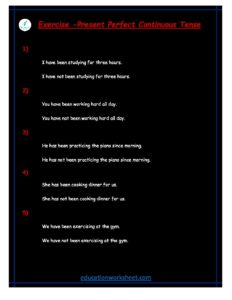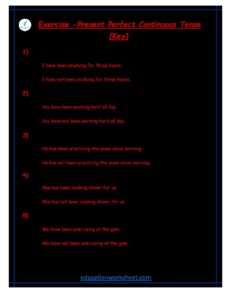changing Present Perfect Continuous Tense to negative and positive worksheets
changing Present Perfect Continuous Tense to negative and positive
The Present Perfect Continuous tense is a versatile and important aspect of English grammar that allows us to express actions or states that have been ongoing up to the present moment. This tense is formed using the auxiliary verb “have” (in its present form, “have” or “has”), followed by “been,” and then the main verb in its present participle form (ending in -ing). It is often used to convey the idea that an action started in the past and has continued up to the present or has just recently stopped.
In this discussion, we will explore how to change the Present Perfect Continuous tense into both negative and positive forms. This will help you understand how to use this tense effectively in various situations.
Changing Present Perfect Continuous Tense to the Positive Form

Let’s start by understanding how to create a positive sentence in the Present Perfect Continuous tense. To do this, follow these steps:
1. Subject:
- Begin your sentence with the subject of the action. The subject can be a person, place, thing, or even a concept. For example:
- “She,” “They,” “The workers,” “I,” etc.
2. Auxiliary Verb:
- After the subject, include the appropriate form of the auxiliary verb “have” (either “have” or “has”) based on the subject.
- “I” and “They” use “have,” while “She” and singular nouns use “has.”
- For example: “She has,” “They have.”
3. Verb “Been”:
- After the auxiliary verb, add the word “been.”
- For example: “She has been,” “They have been.”
4. Main Verb:
- Finally, add the main verb in its present participle form (ending in -ing).
- For example: “She has been working,” “They have been studying.”
Now, you have successfully created a positive sentence in the Present Perfect Continuous tense. These sentences convey the idea that the action has been ongoing up to the present moment. Here are some examples:
- She has been dancing for hours.
- They have been playing soccer since morning.
- The workers have been constructing the building all week.
- I have been reading this book for a while.
Each of these sentences expresses an action that started in the past and has continued up to the present or has just recently stopped.
Changing Present Perfect Continuous Tense to the Negative Form

Now, let’s explore how to convert the Present Perfect Continuous tense into its negative form. To do this, you will need to include the word “not” to indicate negation. Follow these steps:
1. Subject:
- Start with the subject of the action, just like in positive sentences.
- For example: “She,” “They,” “The workers,” “I,” etc.
2. Auxiliary Verb:
- Add the appropriate form of the auxiliary verb “have” (“have” or “has”) based on the subject.
- For example: “She has,” “They have.”
3. “Not” (Negation):
- Insert the word “not” immediately after the auxiliary verb.
- For example: “She has not,” “They have not.”
4. Verb “Been”:
- Continue by adding the word “been” after “not.”
- For example: “She has not been,” “They have not been.”
5. Main Verb:
- Finish the sentence by including the main verb in its present participle form (ending in -ing).
- For example: “She has not been working,” “They have not been studying.”
In this way, you have created a negative sentence in the Present Perfect Continuous tense. These sentences convey the idea that the action has not been ongoing up to the present moment. Here are some examples:
- She has not been dancing for hours.
- They have not been playing soccer since morning.
- The workers have not been constructing the building all week.
- I have not been reading this book for a while.
These negative sentences indicate that the action either did not occur at all or did not continue up to the present moment.
Using the Present Perfect Continuous Tense in Context
Understanding how to form both positive and negative sentences in the Present Perfect Continuous tense is essential for effective communication in English. This tense is often used to describe actions or situations that have a connection to the present moment. Let’s explore some practical examples to illustrate its usage:
Positive Examples:
- She has been studying Spanish for six months.
- This sentence indicates that she started studying Spanish in the past, and her study has continued up to the present moment. It emphasizes the duration of her study.
- They have been working on the project all night.
- Here, the sentence highlights the continuous nature of their work on the project, emphasizing that it started in the past and has not stopped up to the present.
- The chef has been cooking for hours.
- In this case, the chef’s continuous cooking is stressed, implying that the cooking process began some time ago and is still ongoing.
- I have been practicing the piano every day.
- This sentence conveys the idea that the speaker’s daily piano practice has been consistent, starting in the past and continuing into the present.
Negative Examples:
- She has not been studying Spanish for very long.
- In this negative sentence, it’s implied that she hasn’t been studying Spanish for an extended period, contrasting with the positive example.
- They have not been working on the project recently.
- Here, the negative form suggests that their work on the project has paused or stopped, emphasizing the discontinuation of the action.
- The chef has not been cooking much today.
- This sentence indicates that the chef’s cooking activity has been minimal on the current day, highlighting the contrast with a usual state of continuous cooking.
- I have not been practicing the piano lately.
- In this negative sentence, the speaker is expressing that their piano practice has not been happening recently, contrasting with the positive example where it was a daily occurrence.
changing Present Perfect Continuous Tense to negative and positive worksheets
In summary, the Present Perfect Continuous tense is a valuable tool in English grammar for expressing ongoing actions or situations with a connection to the present. By understanding how to form both positive and negative sentences in this tense, you can effectively communicate the duration and continuity of actions or states in various contexts. Practice is key to mastering this aspect of English grammar, so keep honing your skills and applying these principles in your writing and conversations.
changing Present Perfect Continuous Tense to negative and positive Learn how to use the Present Perfect Continuous Tense to describe ongoing actions and events with a positive twist. Improve your English grammar and communication skills today

